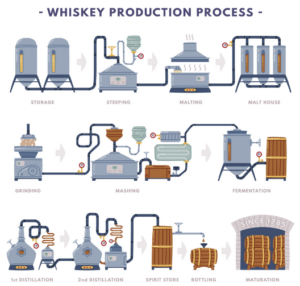Generations have passed down the time-honored tradition of whiskey production, giving rise to one of the world’s most beloved spirits. Hence, this amber elixir, with its rich history and complex flavors, is not merely a drink but a testament to the craftsmanship and dedication of those who produce it. In this article, we will explore the intricate process of whiskey production. From the selection of grains to the aging in oak barrels, uncovering the secrets behind this liquid gold.
Selecting the Finest Grains
At the heart of whiskey production lies the careful selection of grains, a process that sets the stage for the spirit’s distinct characteristics.Barley, corn, rye, and wheat contribute distinct flavors to whiskey production. Initially, grinding the grains into coarse powder forms grist, a vital step that reveals the grains’ starches, later converted to sugars during mashing.
Mashing: Transforming Starches into Sugars
Mashing is the next crucial step in the production of whiskey. The grist is mixed with hot water, allowing the enzymes naturally present in the grains to convert starches into fermentable sugars. This process, known as saccharification, releases the sweet essence that will eventually become alcohol. During this stage, the choice of water quality and temperature is paramount, as they greatly influence the final flavor profile of the whiskey.
Fermentation: Yeast’s Alchemical Dance
Following mashing, the resulting sugary liquid, known as wort, is transferred to fermentation tanks. Here, the magic of yeast takes center stage. Yeast, a microorganism, consumes the sugars present in the wort, producing alcohol and carbon dioxide as byproducts. This fermentation process can take several days and is monitored carefully to achieve the desired alcohol content. The choice of yeast strain can also impact the whiskey’s flavor, ranging from fruity and floral to earthy and spicy notes.
Distillation: Transforming Wort into Spirit
Distillation is where the transformation from wort to whiskey truly begins. The fermented liquid is heated in copper pot stills or column stills, depending on the desired style of whiskey. Distillation separates alcohol from water and other impurities, concentrating the spirit and refining its character. Typically, distillers perform the distillation process twice, referred to as double distillation, to ensure a smoother and more refined final product.
Maturation: The Whiskey’s Journey in Oak Barrels
Following distillation, whiskey makers transfer the clear, high-proof spirit into oak barrels for aging. During this period, it absorbs the wood’s flavors and aromas over several years. This stage is where the whiskey truly gains its complexity and character. The type of oak, the previous contents of the barrels (such as sherry or bourbon), and the length of maturation all play pivotal roles in shaping the final product.
Transitioning from the production process to the aging stage, it’s important to note that whiskey does not mature in a linear fashion. Instead, it undergoes a dynamic aging process, with interactions between the spirit and the wood leading to changes in flavor and color over time.
Blending: The Art of Creating Harmony
Whiskey production often involves blending, a process that marries different barrels and batches to create a harmonious and consistent flavor profile. Master blenders use their expertise to select and combine various whiskey components, aiming to achieve a balanced and complex spirit. This skillful process is akin to composing a symphony of flavors, ensuring that each sip of whiskey is a delightful and memorable experience.

Bottling: The Final Touch
Additionally, as whiskey matures and experts perfect the blending process, the final step involves bottling the spirit. This involves diluting the spirit to the desired bottling strength, typically with pure water, before sealing it in bottles for distribution. The bottling strength can significantly influence the whiskey’s flavor, with higher proof offerings delivering a more robust and intense experience, while lower proof whiskeys offer a milder taste.
Conclusion
In conclusion, the production of whiskey is an artful journey that involves a series of intricate steps, from selecting the finest grains to bottling the finished product. Each phase contributes to the whiskey’s unique character and flavor, making it a cherished spirit enjoyed by connoisseurs worldwide.
Transitioning from tradition to innovation, today’s whiskey producers continue to push the boundaries, experimenting with new grains, cask types, and aging techniques to create exciting and novel expressions of this time-honored spirit. As whiskey enthusiasts savor the diverse flavors and stories behind each bottle, they raise a glass to the dedicated artisans who keep the legacy of whiskey production alive and thriving. Cheers to the liquid gold that has stood the test of time and continues to captivate our palates and imaginations.
